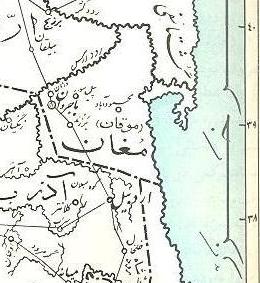|
Talyshstan (region)
Talyshstan (also '' Talish'', ''Talishstan'', ''Tolışıston'') is a historically and nowadays term denoting "''the country of Talysh''". It is also sometimes used to avoid homonymy with the name of the ethnos itself, Talysh, according to the common model of forming the names of territories and countries with the suffix -stan. Divided into two parts: ''Northern Talyshstan'' in Azerbaijan and ''Southern Talyshstan'' in Iran.In the north, it adjoins the Mugan plain in Azerbaijan and stretches in a narrow strip along the southern coast of the Caspian Sea to the settlement of Kopulchal, located near the port of Anzali in Iran.Введение в историю и культуру талышского народа / Под ред. Г. С. Асатряна. — Ереван: Кавказский центр иранистики, 2011. — С. 13, 18, 20. — 200 с. — Talyshstan is also sometimes referred to as the Talysh-Mugan Autonomous Republic, which was declared in ... [...More Info...] [...Related Items...] OR: [Wikipedia] [Google] [Baidu] |
Talysh Language
The Talysh language (زبان تالشی, Tolışə Zıvon, Tолышә зывон), is a Northwestern Iranian language spoken in the northern regions of the Iranian provinces of Gilan and Ardabil and the southern regions of the Republic of Azerbaijan by around 500,000-800,000 people. Talysh language is closely related to the Tati language. It includes many dialects usually divided into three main clusters: Northern (in Azerbaijan and Iran), Central (Iran) and Southern (Iran). Talysh is partially, but not fully, intelligible with Persian. Talysh is classified as "vulnerable" by UNESCO's Atlas of the World's Languages in Danger. History The origin of the name Talysh is not clear but is likely to be quite old. The name of the people appears in early Arabic sources as Al-Taylasân and in Persian as Tâlišân and Tavâliš, which are plural forms of Tâliš. Northern Talysh (in the Republic of Azerbaijan) was historically known as Tâlish-i Guštâsbi. Talysh has always been me ... [...More Info...] [...Related Items...] OR: [Wikipedia] [Google] [Baidu] |
Origin Of The Talysh People
The Talysh people ( tly, Tolışon, script=Latn تالشان; az, Talışlar; fa, تالشان) are an Iranian ethnic group indigenous to a region shared between Azerbaijan and Iran which spans the South Caucasus and the southwestern shore of the Caspian Sea. They speak the Talysh language, one of the Northwestern Iranian languages. It is spoken in the northern regions of the Iranian provinces of Gilan and Ardabil and the southern parts of the Republic of Azerbaijan. The areas in the Republic of Azerbaijan where Northern Talysh is spoken was historically known as Talish-i Gushtasbi. In Iran there is a Talesh County in Gilan Province. Origins The Talyshis have traditionally inhabited the Talish district in the southwestern part of the Caspian Sea, which is usually considered to extend more than 150 km. Today, the northern part of Talish is located in the Republic of Azerbaijan, encompassing the districts of Lankaran, Astara, Lerik, Masally, and Yardimli. ... [...More Info...] [...Related Items...] OR: [Wikipedia] [Google] [Baidu] |
Gelae (Scythian Tribe)
__NoToC__ The Gelae ( grc, Γῆλαι, , or , ''Gélai'' or ''Géloi'' ), or Gelians, were a Scythian tribe mentioned by Strabo and other ancient writers as living on the southern shores of the Caspian Sea, in what is now the Iranian province of Gilan. The name of the province might possibly be derived from the Gelae.''Dictionary of Greek and Roman Geography'', vol. I, p. 986 ("Gelae"). Classical sources According to Strabo, the tribes of the southern Caspian included the Gelae, Cadusii, Amardi, Witii, and Anariacae. If, as seems probable, this description accurately represents their distribution from west to east, then the Gelae would have lived directly east of the river Araxes, along the border of Armenia. Their territory is supposed to have been relatively unproductive, of little agricultural or mineral value. Pliny considers the Gelae and the Cadusii to be synonymous, with "Cadusii" being the tribe's name in Greek, and "Gelae" being its eastern equivalent. If h ... [...More Info...] [...Related Items...] OR: [Wikipedia] [Google] [Baidu] |
Cadusii
The Cadusii (also called Cadusians; grc, Καδούσιοι, ''Kadoúsioi''; Latin: ''Cadusii'') were an ancient Iranian tribe that lived in the mountains between Media and the shore of the Caspian Sea. The area that the Cadusii lived in bordered that of the Anariacae and Albani. The Dareitai and Pantimati people may have been part of the Cadusii. According to tradition, the legendary Assyrian king Ninus subdued the Cadusii. The Greek physician and historian Ctesias () was highly interested in the Cadusii, incorporating them in his invented history of an early Median dynasty. The Cadusii later voluntarily submitted to Cyrus the Great (), the first ruler of the Achaemenid Empire (550 BC–330 BC). According to Xenophon, as Cyrus was about to pass away, he appointed his younger son Tanaoxares (Bardiya) as satrap over the Medes, Armenians, and Cadusii. The Cadusii were most likely part of the satrapy of Media, and perhaps occasionally that of Hyrcania. Although they fought on side o ... [...More Info...] [...Related Items...] OR: [Wikipedia] [Google] [Baidu] |
Mughan (province)
Mughan was a province of the Abbasid Caliphate, in present-day Iranian Azerbaijan. The capital was Bajravan. Other cities were Barzand, Pilsavar, Mahmood Abad and Dezhman. Mughan State was located west of Caspian Sea and south of the Aras river, encompassing the Mughan, namesake plains region. Resources Subdivisions of the Abbasid Caliphate Ardabil Province Azerbaijan under the Abbasid Caliphate History of Talysh {{iran-stub ... [...More Info...] [...Related Items...] OR: [Wikipedia] [Google] [Baidu] |





